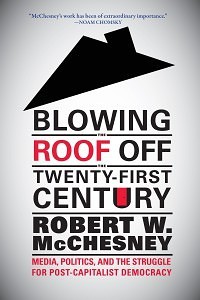Blowing the Roof Off the Twenty-First Century: Media, Politics, and the Struggle for Post-Capitalist Democracy
288 pp, $28 cloth, ISBN 9781583674789
By Robert W. McChesney
Reviewed by Aleah Kiley
Read the review, below, or at the International Journal of Communication (vol. 11, 2017)
Renowned communications scholar and media activist Robert W. McChesney’s most recent work, Blowing the Roof Off the Twenty-First Century: Media, Politics, and the Struggle for Post-Capitalist Democracy, interrogates the state of U.S. politics, mass media, and social reform. Those already familiar with McChesney’s work gain greater insight into his experiences as an activist and his distinctive form of political, economic, and historical analysis beyond communication research. Blowing the Roof is expansive and thematic in organization, fluidly moving between case studies of social movements, reflections on political campaigns, autobiographical accounts of his time in public radio, and analysis of the weakened democratic state. Put simply, McChesney charts the failure of the U.S. democratic process, which has become overrun by capitalist interests and obfuscated by electoral politics. With the urgency and force that is characteristic of McChesney’s writing, Blowing the Roof offers a disquieting account of civic action in 21st-century postcapitalist democracy, which has continually routed flows of profit toward an ever-narrowing but increasingly powerful elite, while shrinking streams of resources to a widening and disenfranchised working poor.
Resonant with his extensive body of work, McChesney combines historical, economic, political, and social analysis to construct a periodized model of history. From this vantage, at key moments in history, dynamic forces converge to impact structural change and reprioritize social values. This type of analysis is constitutive of McChesney’s dialectical approach to critical political economy, which entails (1) sketching the timelines and implications of entrenched monopoly capitalism in the United States, (2) recovering key moments of disruption and contradiction in those processes, and (3) offering pathways for immediate political mobilization and long term social change. Engaging this approach, chapter 1, “America, I Do Mind Dying,” suggests that the rapid acceleration of inequality and mounting popular discontent is indicative of another key period in which the values and priorities of the U.S. political system are “ready to blow.” Tapping into the immediacy of “history in the making,” McChesney asserts that the first step of “arousing the citizenry” is to remind them of their own history.
Writing in an accessible yet nuanced style, McChesney’s call to action is decidedly compassionate. As a seasoned activist who has stood on the front lines of media reform and has brought critical political economy beyond academic borders, he takes care to appeal to younger generations steeped in a heavily depoliticized social atmosphere. Here, McChesney embraces a sense of humility by acknowledging a “selffulfilling” pessimism that has permeated the electorate and admittedly overwhelmed him at times.
As Noam Chomsky put it, if you act like social change for the better is impossible, you guarantee it will be impossible. That is the choice we all have to make when we look into the mirror. Pessimism is self-fulfilling; it is no way to live. (p. 17)
This emphasis on open-ended possibility, sustained optimism, and empathic empowerment is refreshing and characterizes this work. Beyond acknowledging the apathetic zeitgeist of the day, McChesney seems reinvigorated by the call to make critical political economy accessible to a new generation of activists and scholars. Blowing the Roof is a sophisticated demonstration of the strength of the critical economic project and a convincing call to reinvest in the multivalent approach that engages in historical, moral, and holistic structural analysis to mobilize social action and affect political change.
Part 1, “Putting the Politics Back in Political Economy,” traces the contributions and failings of left political leaders from Roosevelt to Obama and draws out the structural impediments to progressive change within the constraints of late capitalism. Chapter 2, “After the Nader Campaign: The Future of U.S. Left Electoral Politics,” highlights that Nader’s presence on the 2000 presidential ticket elucidated the importance of third-party candidates to mobilize ideas outside the narrow range of “legitimate debate.” In chapter 3, “A New New Deal Under Obama?” McChesney places the popularly debated “salvage operation” of Obama’s stimulus plan into an historical context through the reconsideration of Roosevelt’s New Deal. Breathing new life into Baran and Sweezy’s “civilian government ceiling thesis” (Baran & Sweezy, 1966), McChesney asserts that during financial crisis, initial “salvage efforts” are needed to stabilize the economy (Roosevelt’s first New Deal), but that it is only through greater public funding and reprioritization of civilian spending that social programs can develop and social welfare can improve (Roosevelt’s second New Deal).
In Chapter 4, “The Wisconsin Uprising,” McChesney details the 2011 Wisconsin protests, and the moral dimension and accessible tone of his work shines through: “The cynical claim that the American people are a bunch of shop-till-you-drop airheads incapable of critical thought was purged from my system. It made me remember that people are far more complex and beautiful” (p. 63). After detailing the tension between his inspired experience and the subsequent distorted media attention, McChesney reveals the ways in which the “range of legitimate debate (that is, the range countenanced by capital)” (p. 64) expunges dissent from the public record. Examining the failure of these capital-driven projects, chapter 5, “This Isn’t What Democracy Looks Like,” charts the ways in which the rule of money has eclipsed the rule of people. In this dramatically weakened political system, which he and John Nichols term a “Dollarocracy,” those with the most dollars get the most votes, and capital rather than public interest puts the wheels of politics in motion.
In part 2, “Money Doesn’t Talk, It Swears,” McChesney exposes the entrenched interdependence between national security and business interests. In chapter 6, “The U.S. Imperial Triangle and Military Spending,” he interrogates claims that the post-9/11 political climate fueled “neoconservative ‘political crazies’” to engage in a new unbridled militarism. Challenging this historically abbreviated view, McChesney traces an established commitment to a “permanent war economy” through a “bastardized form of Keynesianism” (p. 145) that uses active military engagement, Cold War, and preemptive action (War on Terror) to stimulate employment, technological development, political power, and cultural pride. Chapter 7, “The Penal State in an Age of Crisis,” details the domestic side of a militarized U.S. state through charting massive increases in imprisonment, privatized state prison economies, and expanding
prison labor operations. McChesney asserts that the rapid acceleration of the prison complex is directly proportional to the magnifying failures of capitalism. It is not an accident that the majority of those imprisoned in the United States are vulnerable populations―Latinos, immigrants, African Americans, and the chronically mentally ill―whose struggles expose the failures of economic injustice and anemic social welfare programs.
Part 3, “Media and Politics,” explores the state of media reform. As this is a familiar topic for McChesney, he uses the opportunity to provide alternative insights, with two of the three chapters including autobiographical content. Chapter 8, “The State of Media and Media Reform,” is an interview in which McChesney revisits key moments of his journey as an activist and academic, detailing how critical sociologists, political scientists, and economists deepened his commitment to social justice as “part of an evolving social organism with tremendous dependency on others for survival” (p. 159). Chapter 9, “Walter Lippmann and the Crisis of Journalism,” reexamines Lippmann’s writings of the 1910s and 1920s to consider the role of social media in contemporary journalism. McChesney moves beyond his convincing critique of profit-oriented journalism (see The Death and Life of American Journalism: The Media Revolution that will Begin the World Again, McChesney & Nichols, 2010) to consider the nature of public involvement, ethics, and values in journalism more broadly. Chapter 10, “The Personal Is Political: My Career in Public Radio,” reflects on his time as a host for Media Matters, a weekly NPR public affairs program. This chapter is an engaging account of how a public forum can voice lived realities, stimulate critical analysis, mobilize political action, and expose the rigidity of the established media apparatus.
In part 4, “Bringing It All Back Home,” McChesney successfully articulates the ways in which the problems of media systems are the problems of democracy. Chapter 11, “The Cultural Apparatus of Monopoly Capital,” asks us to imagine, like many critical thinkers have before, how reforming the privatized media system might mobilize the left, engender democratic engagement, and create sustainable socialist systems. Chapter 12, “A Sharp Left Turn for the Media Reform Movement,” draws on the breadth of the book to propose three key policy changes, including promoting net neutrality policies, regulating Internet giants as monopolies, and treating journalism as a public good. Moving forward, he asserts that the guiding contradiction of “what is good and rational for those who control the economy is bad and irrational for society as a whole” (p. 229) must be exposed, confronted, and structurally addressed.
It is impossible to ignore the ways in which the 2016 election cycle gives Blowing the Roof a prophetic quality. The 2016 candidates exploded the vacuous rhetoric of both the Democratic and Republican parties by exposing the possibilities of socialist ideas and the entrenched priorities of crony capitalism. This was a fight between core values and principles that McChesney’s book allows us to understand more fully. As the chapters unfold, the highlights and margins explode with connections, insights, and understanding.
References
- Baran, P. A., & Sweezy, P. M. (1966). Monopoly capital. New York, NY: Monthly Review Press.
- McChesney, R. W., & Nichols, J. (2010). The death and life of American journalism: The media revolution that will begin the world again. New York, NY: Nation Books.
Copyright © 2017 (Aleah Kiley, [email protected]). Licensed under the Creative Commons Attribution Non-commercial No Derivatives (by-nc-nd)


Comments are closed.